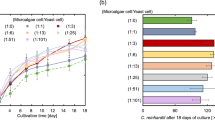Abstract
The nitrogen-fixing capacity of four cyanobacterial strains was tested in relation to heterotrophic ability, tolerance to combined nitrogen and adaptive capacity to changes in light intensity and pH. Strains (Anabaena variabilis UAM 202;Calothrix marchica UAM 214;Nodularia spumigena UAM 204,Nostoc punctiforme UAM 205) were isolated from the rice-fields of Valencia (Spain).C. marchica, was the only strain able to grow and to fix dinitrogen under heterotrophic conditions, with fructose and glucose. Fructose was the best substrate supporting growth and dinitrogen fixation in mixotrophy (growth in the light under conditions where CO2 and organic carbon are assimilated simultaneously), photoheterotrophy (growth in the light on an organic compound in the absence of net CO2 fixation) and heterotrophy (growth on an organic compound in the dark). Ammonium repressed nitrogenase more than nitrate. Full repression was observed only at concentrations of combined nitrogen higher than those usually found in rice-fields. Carbohydrates had a protective effect on nitrogenase against ammonium inhibition inC. marchica. All four strains showed increased nitrogenase activity when the light intensity was increased during assays. Variations of pH normally occurring in rice fields led to no important changes in nitrogenase activity inC. marchica. This fact, together with its potential for heterotrophic growth and tolerance to combined nitrogen, make this the most suitable of the four strains for inoculation experiments in rice fields.
Similar content being viewed by others
References
Desikachary TV (1959)Cyanophyta. Indian Council of Agricultural Research, Delhi, 686 pp.
Fay P (1981) Photosynthetic micro-organisms. In: Broughton W (ed.), Nitrogen fixation. Clarendon Press, Oxford, 1–29.
Fernandez-Valiente E, Sanchez-Maeso E, Nieva M, Avendaño M (1991) Photosynthesis and respiration in mixotrophic cultures of the cyanobacteriumAnabaena variabilis. In: Polsinelli M, Materassi R, Vincenzini M (eds), Nitrogen fixation. Kluwer Academic Publishers, Dordrecht, 425–430.
Geitler L (1932)Cyanophyceae. In: Rabenhorst L (ed.), Kryptogamenflora von Deutschland, Österreich und der Schweiz, 14, kademische Verlagsgesellschaft, Leipzig, 1056 pp.
Guerrero MG, Lara C (1987) Assimilation of inorganic nitrogen. In: Fay P, Van Baalen C (eds), The Cyanobacteria, Elsevier Science Publishers, Amsterdam, 164–187.
Khoja TM, Whitton BA (1971) Heterotrophic growth of blue-green algae. Arch. Mikrobiol. 79: 280–282.
Leganes F, Fernandez-Valiente E (1991) The relationship between the availability of external CO2 and nitrogenase activity in the cyanobacteriumNostoc UAM 205. J. Plant Physiol. 139: 135–139.
Mateo P, Bonilla I, Fernandez-Valiente E, Sanchez-Maeso E (1986) Essenciality of boron for dinitrogen fixation inAnabaena sp. PCC 7119. Plant. Physiol. 81: 430–433.
Nieva M, Avendaño M, Sanchez-Maeso E, Fernandez-Valiente E (1990) Effect of sodium deficiency on mixotrophic cultures ofAnabaena variabilis. J. Plant Physiol. 136: 626–630.
Quesada A (1990) Estudio de las poblaciones naturales de cianobacterias presentes en los arrozales valencianos. PhD thesis. Universidad Autonoma de Madrid, Madrid, Spain.
Reddy PM, Roger PA (1988) Dynamics of algal populations and acetylene-reducing activity in five rice soils inoculated with blue-green algae. Biol. Fert. Soils 6: 14–21.
Rippka R, Deruelles J, Waterbury JB, Herdman M, Stanier RY (1979) Generic assignments, strain histories and properties of pure cultures of cyanobacteria. J. gen. Microbiol. 111: 1–61.
Roger PA (1989) Cyanobacteries et riziculture. Bull. Soc. bot. Fr. 136: 67–81.
Roger PA, Kulasooriya SA (1980) Blue-green algae and rice. IRRI, Manila, Philippines. 112 pp.
Roger PA, Santiago-Ardales S, Reddy PA, Watanabe I (1987) The abundance of heterocystous blue-green algae in rice soils and inocula used for application in rice fields. Biol. Fertil. Soils 5: 98–105.
Roger PA, Watanabe I (1986) Technologies for utilizing biological nitrogen fixation in wetland rice: potentialities, current usage and limiting factors. Fertil. Res. 9: 39–77.
Rozen A, Arad H, Schonfeld M, Tel-Or E (1986) Fructose supports glycogen accumulation, heterocyst differentiation, nitrogen fixation and growth of isolated cyanobiontAnabaena azollae. Arch. Microbiol. 145: 187–190.
Smith AJ (1982) Modes of cyanobacterial carbon metabolism. In: Carr NG, Whitton BA (eds), The biology of cyanobacteria, Blackwell Scientific Publications, Oxford, 47–86.
Venkataraman GS (1981) Blue-green algae for rice production. FAO Soil Bull. 46.
Whitton BA, Roger P (1989) Use of blue-green andAzolla in rice culture. In: Campbell R, MacDonald R (eds), Microbial inoculation of crop plants. IRL Press at Oxford University Press, Oxford, 25: 89–100.
Whitton BA, Rother J, Paul A (1988) Ecology of deepwater rice fields in Bangladesh. 2. Chemistry of sites at Manikganj and Sonargaon. Hydrobiologia 169: 23–30.
Author information
Authors and Affiliations
Rights and permissions
About this article
Cite this article
Prosperi, C., Boluda, L., Luna, C. et al. Environmental factors affectingin vitro nitrogenase activity of cyanobacteria isolated from rice-fields. J Appl Phycol 4, 197–204 (1992). https://doi.org/10.1007/BF02161205
Received:
Revised:
Accepted:
Issue Date:
DOI: https://doi.org/10.1007/BF02161205




